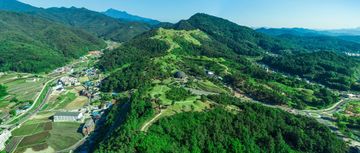고령 지산동 고분군(가야고분군)
| 고령 지산동 고분군 Ancient Tombs in Jisan-dong, Goryeong |
|
 고령 지산동 고분군, 가야고분군 세계유산등재추진단. |
|
| 대표명칭 | 고령 지산동 고분군 |
|---|---|
| 영문명칭 | Ancient Tombs in Jisan-dong, Goryeong |
| 한자 | 高靈 池山洞 古墳群 |
| 주소 | 경상북도 고령군 대가야읍 지산리 산8번지 일원 |
| 지정(등록) 종목 | 사적 제79호 |
| 지정(등록)일 | 1963년 1월 21일 |
| 분류 | 유적건조물/무덤/무덤/고분군 |
| 시대 | 가야 |
| 수량/면적 | 830,181㎡ |
| 웹사이트 | 고령 지산동 고분군, 국가문화유산포털, 문화재청. |
|
|
|
해설문
국문
지산동고분군은 5세기부터 6세기까지 가야 북부지역에서 후기가야의 주요 세력으로 성장한 대가야 지배자들의 무덤들이다. 고분군은 높은 산자락에 위치하여 경관이 빼어나며 가야 고분군 중에서 가장 큰 규모를 자랑한다.
고분의 규모가 클수록 전망이 좋은 높은 곳에 위치하고 있으며 큰 고분 주위에는 하위 지배층의 고분을 호위하듯 배치하였다. 30·44·45호분 등 대형 고분은 주곽의 주위에 10~40명의 순장자를 함께 묻어 위계를 표현하였다.
고분에 부장된 각종 유물은 대가야의 문화적 특성을 잘 보여준다. 대가야 양식의 토기는 5세기 후반이 되면 합천과 남원 등 가야 전역에서 출토되어 후기 가야연맹을 주도한 대가야의 영향력을 뚜렷하게 보여준다. 44호분에 부장된 백제 무령왕릉 출토품과 같은 형태의 청동그릇, 일본 오키나와산 야광조개로 만든 국자, 45호분에 부장된 신라 황남대총 남분 출토품과 같은 형태의 세잎무늬 고리자루큰칼, 일본 전역에서 출토되는 대가야 양식의 귀걸이와 마구류 등은 대가야의 활발한 교류관계를 보여준다.
지산동고분군은 가야 사회의 계층구조와 대내외 교류를 가장 잘 보여주는 가야 후기의 대표 고분군이다.
영문
Ancient Tombs in Jisan-dong, Goryeong
These tombs are presumed to have been built between the 5th and 6th centuries for the rulers of Daegaya, one of the members of the Gaya confederacy (42-562). Daegaya was located in the northern area of the Gaya confederacy, which is today’s Goryeong area, and played a leading role in the confederacy from the 5th century until it was annexed by the Silla kingdom (57 BCE-935 CE) in 562.
Since the 1910s, a number of excavations and surveys have been conducted, revealing that there are more than 700 tomb mounds scattered across 814,816 sq. m of land, and that most of the tombs are stone-lined pit tombs. If tombs that have lost their mounds are included, it is presumed that this complex contains nearly 10,000 tombs, which makes it the largest among the seven ancient tomb complexes of the Gaya confederacy. The largest tomb mounds are situated at higher elevations and belonged to the rulers. Some of these tombs were found with human sacrifices ranging from 10 to 40 individuals, attesting to the rulers' powerful authority.
Various burial goods found inside the tombs show Daegaya’s cultural features. For example, long-necked jars with a lid and cylindrical vessel stands, which are Daegaya-style wares dating to the late 5th century, have been discovered in the former territory of all of the member states of the Gaya confederacy, which shows Daegaya’s strong influence over the confederacy. Also, other excavated artifacts attest to Daegaya’s exchange with neighboring kingdoms, such as bronze bowls similar to those found in the royal tombs of the Baekje kingdom, swords with pommel similar to those found in the royal tombs of the Silla kingdom, and a ladle made with luminous shell from Okinawa. Earrings and horse harnesses from Daegaya have also been excavated from archaeological sites in Japan.
영문 해설 내용
이 고분군은 가야연맹의 한 나라인 대가야 지배자들의 무덤으로, 5세기부터 6세기까지 조성된 것으로 추정된다. 대가야는 5세기부터 가야 북부 지역(지금의 고령 지역)에서 후기 가야의 주요 세력으로 성장했으며, 562년 신라에 복속되었다.
1910년대부터 현재까지 지속적인 조사 및 발굴을 통해 약 814,816㎡ 규모의 넓은 구역에 700여기 이상의 봉토분이 분포하고 있는 것으로 확인되었으며, 대부분 수혈식 석곽묘로 만들어졌다. 봉분이 유실된 것 등을 포함하면 약 만여 기에 달하는 고분이 있는 것으로 보이며, 이는 7개의 가야고분군 가운데 가장 큰 규모이다. 높은 곳에 위치한 대형 고분은 주곽 주위에 10-40명의 순장자를 함께 묻어 피장자의 위계를 표현하였다.
고분에 부장된 각종 유물은 대가야의 문화적 특성을 잘 보여준다. 유개식장경호와 통모양그릇받침과 같은 5세기 후반 대가야 양식의 토기는 가야 전역에서 출토되어, 가야연맹을 주도한 대가야의 영향력을 뚜렷하게 보여준다. 또한 인근 국가들과의 교류 관계를 보여주는 유물도 다수 출토되었는데, 백제의 왕릉에서 발견된 것과 같은 형태의 청동 그릇, 신라 황남대총 남분에서 발견된 것과 같은 형태의 고리자루큰칼, 일본 오키나와산 야광조개로 만든 국자 등이 있다. 대가야 양식의 귀걸이와 마구류 등은 일본 전역에서도 출토되었다.